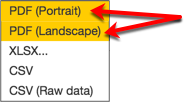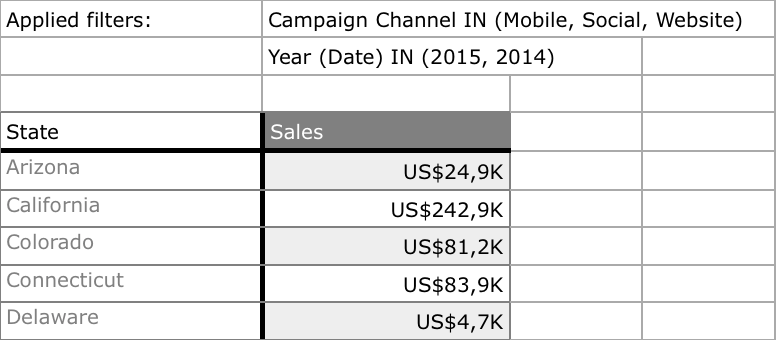Export File Types
In GoodData, you can export your reports as the following file types:
- PNG
- XLSX
- CSV
If you are not sure which type to use, the following table shows possible scenarios:
| I want to | Export to |
|---|---|
| Show reports, no further analysis necessary | PDF, PNG |
| Analyze data in a spreadsheet | XLSX, CSV |
| Analyze data in another application | CSV (Raw data) |
For details about how to export, see Export Reports.
Use PDF export if you do not need to process the data further and you want to show the reports and charts.
If you export from a table report, you can select the page orientation.

Geo charts exported to PDF contain only the top data layer and do not display filters.
Custom PDF Scaling
You can use the API Reference to customize the exported PDF file.
Fit the report to a maximum number of pages.
Shrink or enlarge the report by percentage.
By default, when you export a report as a PDF in landscape orientation, the width of the report is scaled to fit a single page.
Custom PDF Headers and Footers
For details, see Configure Custom Headers and Footers for PDF Report Exports.
PNG
Export to a PNG file if you do not need to process the data further and you want to, for example, insert them into a presentation.
XLSX
Export your data to an XLSX file if you want to analyze the formatted data in a spreadsheet.
By default, reports that are grouped by attributes contain merged cells in the exported XLSX file.
You cannot export geo charts and key metric widgets to XSLX.
You can also export an entire dashboard tab to XLSX from the Dashboard section. For details, see Export Reports.
XLSX with Unmerged Cells
For more granular analysis, you can export your data to XLSX with unmerged cells.
Steps:
Start exporting the report or dashboard tab to XLSX.
In the Export to XLSX dialog, unselect Keep attribute cells merged.

Click Export and save the file.
The following image shows the difference between exported data with merged and unmerged cells in the Date (Date) column.
By default, the Keep attribute cells merged option in the export dialog is selected. To change the default status, set the cellMergedByDefault platform setting to false. For details, see Configure Various Features via Platform Settings.
XLSX with Active Filters Displayed
If you have any filter enabled in the report, you can add the description of the filters to the exported XLSX file.
Steps:
Start exporting the report or dashboard tab to XLSX.
In the Export to XLSX dialog, select Include active filters in each report.

Click Export and save the file.
The following image shows the exported data with the active filters' description at the top.
If the report includes a date filter, the XLSX file displays this filter in MAQL.
Examples:
- If you filter to previous year, the filter says
THIS-1. - If you filter to two previous weeks, the filter says
BETWEEN THIS-2 AND THIS-1.
THIS always represents the time dimension used in the filter, such as week, year, month, or day.
By default, the Include active filters in each report option is selected. To change the default status, set the activeFiltersByDefault platform setting to false. For details, see Configure Various Features via Platform Settings.
To disable this feature and hide the option from the Export to XLSX dialogue, contact the GoodData Support.
If you define custom headers for XLSX exports, the active filters are placed under the custom headers. For details, see Configure Custom Headers for XLSX Exports.
Custom Headers
You can add up to five rows of additional text when exporting data to an XLSX file. For details, see Configure Custom Headers for XLSX Exports.
Custom Number Format
By default, when a report is exported to XLSX, the number formats applied to the cells containing metrics are propagated to the result XLSX file exactly as defined in the report. For example, if some metrics in a report have a number format that displays negative numbers in red and positive numbers in green, this format will be applied to the cells with these metrics in the XLSX file.
To apply a single number format to all the cells containing metrics in the result XLSX file instead of their original number formats, set the exporter.tabularExport.fixedExcelFormat platform setting to the desired number format. For details, see Configure Various Features via Platform Settings.
The number format defined in the platform setting is applied only to XLSX files. The number formats in the reports themselves do not change.
Export Dashboard Tabs to XLSX
When you export a dashboard tab to an XLSX file, each report from the tab is displayed on a separate worksheet as a table. For details, see “Export from the Dashboard” in Export Reports.
Order of the Worksheets
The order of the worksheets with reports is always based on the proximity of the center of the report to the top left corner of the dashboard.
Example:
The reports in the image below will export in the following order:
- % Leads
- Top Retail brands
- Heatmap: Spend by campaign
CSV and CSV with Raw Data
If you want to export large reports, process report data in more detail in another application, and do not need formatting, export the report as a CSV file.
For additional details about raw data exports, see Exporting Raw Report Data.
When you export to CSV, formulas in attribute and attribute header cells are automatically escaped using quotation marks. This does not apply to raw CSV exports. To turn this feature off, contact GoodData Support.



